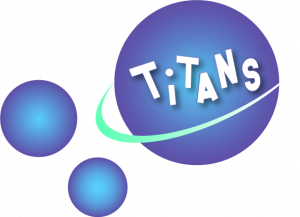
This year resulted in four new publications produced by TRANSAT consortium members.
Tritium measurements by nuclear reaction analysis using ³He beam in the energy range between 0.7 MeV and 5.1 MeV, S. Markelj, M. Payet, E. Bernard, M. Lipoglašek, M. Kelemen, A. Cvetinović, C. Grisolia, P. Pelicon.
A solid thick tritiated W sample was produced in order to probe the efficiency of detecting tritium via 3He ion beam using nuclear reactions analysis (NRA). Extensive literature search showed that there were only a few measurements done more than sixty years ago using the reaction with 3He. Their aim was mainly to measure the absolute cross section of the reaction. In order to use this reaction as an analysing tool for low level radioactive waste we need the differential cross section at certain angles. Using a thick tritiated W sample we measured the NRA signal in the 3He energy range from 0.7 MeV to 5.1 MeV and we have detected reaction products with energies between 6.5 MeV and 9.75 MeV that were not present on a deuterated W sample prepared in the same manner. This NRA signal proved to be due to deuterium and protons coming from the nuclear reaction between tritium and 3He. The detection signal increased with 3He energy up to 3.4 MeV and decreased with energy at the highest beam energies. At higher energies particles from W and target impurities start to disturb the measurement. Their origin might be due to other nuclear reactions, for example between 3He and W or 3He with 13C or 14N. Access publication
Double pulse laser-induced plasmas on W and Al by ps-LIBS: Focus on the plasma-second pulse interaction, A. Favre, V. Morel, A. Bultel, S. Idlahcen, A. Benyagoub, I. Monnet, A. Sémérok, M. Dinescu, S. Markelj, P. Magaud, C. Grisolia.
The LIBS (laser-induced breakdown spectroscopy) method can be implemented to determine the multi-elemental composition of solid samples. Unfortunately, the precision of the usual LIBS configuration (single pulse) is rather low for light elements in metallic matrices. The double pulse configuration can help to overcome this difficulty. Indeed, the electron temperature and density are significantly increased by the second pulse absorbed by the plasma produced by the first pulse which leads to a higher signal-to-noise ratio. The present paper reports preliminary results in double pulse configuration on fusion-relevant materials, i.e. aluminum (considered as a beryllium surrogate) and tunsgten, in the perspective of the test of this technique to measure in situ the hydrogen isotopes concentration of the divertor and the first wall of an ITER-like tokamak. The plasma spectroscopic analysis is performed to derive the gain in electron density reached by the absorption of the second pulse. In parallel, the spectral absorptivity of the plasma regarding the second pulse is determined to correlate the electron density dynamics to the energy deposit. The absorption by the plasma of the second pulse is then quantified at the atomic and macroscopic scales. Access publication
Comparison of two modelling tools for the evaluation of tritium and hydrogen transfers in nuclear reactors or complex systems, T. Gilardi, C. Moreno, C. Grisolia.
In the framework of the TRANSAT project, started in 2017 (TRANSversal Actions for Tritium supported within the H2020 Euratom program), the ability to measure and to assess the tritium inventory and migration within different kinds of reactors or processes is one major challenge to control the potential releases and personal dosimetry in nominal operating conditions. A benchmarking activity between two calculation tools developed either for the fusion machines (EcosimPro developed between CIEMAT and EAI) or for the fission reactors (KUTIM developed at CEA), was initiated to improve the level of confidence in the tritium and hydrogen balances estimated by such codes in complex systems. Access publication
A 3D In Vitro Model of the Human Airway Epithelium Exposed to Tritiated Water: Dosimetric Estimate and Cytotoxic Effects, G. Baiocco, I. George, S. Garcia-Argote, I. Guardamagna, L. Lonati, Y. Lamartinière, T. Orsière, B. Rousseau, A. Ottolenghi, A. Jha, L. Lebaron-Jacobs, C. Grisolia, V. Malard.
Tritium has been receiving worldwide attention, particularly because of its production and use in existing fission reactors and future nuclear fusion technologies, leading to an increased risk of release in the environment. Linking human health effects to low-dose tritium exposures presents a challenge for many reasons. Among these: biological effects strongly depend on the speciation of tritiated products and exposure pathway; large dosimetric uncertainties may exist; measurements using in vitro cell cultures generally lack a description of effects at the tissue level, while large-scale animal studies might be ethically questionable and too highly demanding in terms of resources. In this context, three-dimensional models of the human airway epithelium are a powerful tool to investigate potential toxicity induced upon inhalation of radioactive products in controlled physiological conditions. In this study we exposed such a model to tritiated water (HTO) for 24 h, with a range of activity levels (up to ∼33 kBq µl-1 cm-2). After the exposures, we measured cell viability, integrity of epithelial layer and pro-inflammatory response at different post-exposure time-points. We also quantified tritium absorption and performed dosimetric estimates considering HTO passage through the epithelial layer, leading to reconstructed upper limits for the dose to the tissue of less than 50 cGy cumulative dose for the highest activity. Upon exposure to the highest activity, cell viability was not decreased; however, we observed a small effect on epithelial integrity and an inflammatory response persisting after seven days. These results represent a reference condition and will guide future experiments using human airway epithelium to investigate the effects of other peculiar tritiated products. Access publication

